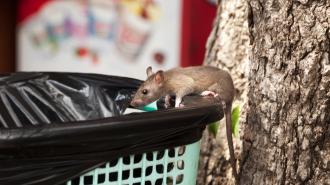A rodent control company is offering cities internet-connected rat traps, which send alerts every time an animal is detected or killed — giving them a way to leverage data and modern technology in the centuries-long battle against rodent infestations.
Why it matters: Rats and mice love cities — we provide them with plenty of food to eat, while our buildings offer them shelter from cold, predators, and the elements.
In return, rats transmit diseases to us through bites, feces, and urine, and destroy our property, chewing through wiring, insulation, and pretty much anything else that gets in their way.
Two rats can have 15,000 descendants in as little as 12 months.
The challenge: Despite having literally thousands of ideas for rodent traps, our attempts to control these destructive pests have generally failed.
They’re so smart that killing them with poison is difficult — if a rat encounters an unfamiliar food in a trap, for example, it’ll often eat just a little at first to see if it makes it ill.
They also breed very quickly — two rats can have 15,000 descendants in as little as 12 months — which makes it hard for cities to permanently decrease pest populations, or even monitor the efficacy of rodent control initiatives.
What’s new? Several U.S. cities are now taking a 21st century approach to rodent control, using a system of sensors and internet-connected “smart traps” developed by pest control company Anticimex.
“It gives us information to take a more holistic approach to rodent control rather than just being reactive.”
Dana Cote
The company’s above-ground trap is a box about the size of a small trash bin. When a rodent enters, sensors in the box detect its movement and body heat. This triggers a function that electrocutes the animal. The trap resets after the rat is moved to a separate container.
“[T]hat eliminates a lot of secondary pest issues, like flies and, you know, sightings and all of that,” Dana Cote, Anticimex’s director of SMART operations, told Axios.
Anticimex has a below-ground rodent control system designed for use in sewers, too. It also uses sensors to detect the presence of a rat, but instead of electricity, it uses blunt force (like an old-fashioned spring mouse trap). The animal’s body is then washed away by the flow of sewage.
Data driven: Anticimex’s rat traps send alerts every time a rodent is killed. The company also offers sensors that don’t trap or kill animals, but simply detect their movements and send alerts whenever one is spotted.
Together, these alerts can help guide rodent control efforts — if a city notices that a certain area is particularly active with rats, for example, it might consider adding more traps near that location.
“It gives us information to take a more holistic approach to rodent control rather than just being reactive — ‘I saw something, we killed it, okay, it’s gone, next one,'” Cote said. “It’s more of an educational process as well.”
A new weapon: It’s highly unlikely that Anticimex’s smart traps will be enough to win humanity’s war against rats. However, its poison-free approach is better for the environment, and its data is making it easier for officials to plan their response efforts.
“The program has been pretty successful so far and allows us to track movement and deploy things as necessary based on the numbers we are seeing,” Jessica Grondin, director of communications and digital services in Portland, Maine, which has been using the traps since April 2021, told Route Fifty.
We’d love to hear from you! If you have a comment about this article or if you have a tip for a future Freethink story, please email us at [email protected].






